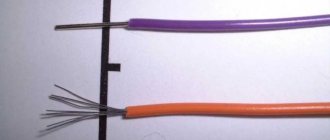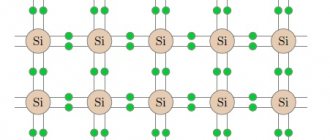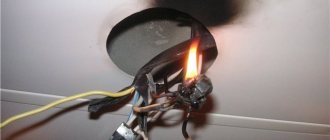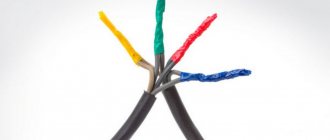Due to the fact that there are two types of electrical resistances -
In connection with the electromagnetic phenomena that arise in conductors when alternating current passes through them, two physical phenomena that are important for their electrical properties arise.
The last two phenomena make it ineffective to use conductors with a radius greater than the characteristic depth of penetration of electric current into the conductor. Effective conductor diameter (2RBhar): 50Hz -7 Ohm. Using microohmmeters, you can determine the quality of electrical contacts, the resistance of electrical busbars, windings of transformers, electric motors and generators, the presence of defects and foreign metal in ingots (for example, the resistance of a pure gold ingot is half that of a gold-plated tungsten ingot).
To calculate the length of the wire, its diameter and the required electrical resistance, it is necessary to know the resistivity of the conductors ρ.
In the international system of units, resistivity ρ is expressed by the formula:
It means: the electrical resistance of 1 meter of wire (in Ohms), with a cross-section of 1 mm 2, at a temperature of 20 degrees Celsius.
Production technology
To obtain a superconductor, a conductive layer consisting of an alloy of nickel and copper is applied to a copper wire in a vacuum along its entire perimeter, with diffusion into the surface layer of the base wire. A protective layer of metal is applied to the outside. After which the resulting wire is annealed in a vacuum for 30 - 180 minutes at 850-950 o C. To create a copper-nickel wire, pure (99.99) copper and nickel are used.
The effect of increased conductivity is formed in an alloy layer consisting of two metals, which is a thin-walled conductive tube-interlayer. Thanks to the diffusion interaction of the metal layers adjacent to the interlayer tube on both sides, the surface is almost ideal.
The application of wire layers occurs in vacuum equipment to prevent oxidation of the conductive layer. Therefore, the length depends on the capabilities of the vacuum equipment.
Calculation of resistivity of copper-nickel wire
High electrical conductivity is found in copper and aluminum, as well as in gold and silver. In other metals, electrical conductivity is significantly lower.
Table of electrical resistivity of metals
Due to the fact that there are two types of electrical resistances -
In connection with the electromagnetic phenomena that arise in conductors when alternating current passes through them, two physical phenomena that are important for their electrical properties arise.
The last two phenomena make it ineffective to use conductors with a radius greater than the characteristic depth of penetration of electric current into the conductor. Effective conductor diameter (2RBhar): 50Hz -7 Ohm. Using microohmmeters, you can determine the quality of electrical contacts, the resistance of electrical busbars, windings of transformers, electric motors and generators, the presence of defects and foreign metal in ingots (for example, the resistance of a pure gold ingot is half that of a gold-plated tungsten ingot).
To calculate the length of the wire, its diameter and the required electrical resistance, it is necessary to know the resistivity of the conductors ρ.
In the international system of units, resistivity ρ is expressed by the formula:
It means: the electrical resistance of 1 meter of wire (in Ohms), with a cross-section of 1 mm 2, at a temperature of 20 degrees Celsius.
What is the resistance of copper wire
In metals, a current is formed when an electric field appears. It “forces” electrons to move in an orderly manner, in one direction. Electrons from the distant orbits of an atom, weakly held by the nucleus, form a current.
Copper wires
As negative particles pass through the crystal lattice of copper molecules, they collide with atoms and other electrons. There is an obstacle or resistance to the directional movement of particles.
To evaluate the resistance to current, the value of “electrical resistance” or “electrical impedance” was introduced. It is designated by the letter “R” or “r”. Resistance is calculated using Georg Ohm's formula: R=, where U is the potential difference or voltage acting on a section of the circuit, I is the current strength.
Concept of resistance
Important! The higher the impedance value of a metal, the less current passes through it, and it is copper conductors that are so widespread in electrical engineering due to this property. Based on Ohm's formula, the current value is affected by the applied voltage at constant R
But the resistance of copper wires varies, depending on their physical characteristics and operating conditions.
Based on Ohm's formula, the magnitude of the current is affected by the applied voltage at a constant R. But the resistance of copper wires varies depending on their physical characteristics and operating conditions.
Conductor resistivity table
| Conductor material | Specific resistance ρ in |
| Silver Copper Gold Brass Aluminum Sodium Iridium Tungsten Zinc Molybdenum Nickel Bronze Iron Steel Tin Lead Nickelin (an alloy of copper, nickel and zinc) Manganin (an alloy of copper, nickel and manganese) Constantan (an alloy of copper, nickel and aluminum) Titanium Mercury Nichrome (an alloy of nickel, chromium, iron and manganese) Fechral Bismuth Chromal | 0,015 0,0175 0,023 0,025. 0,108 0,028 0,047 0,0474 0,05 0,054 0,059 0,087 0,095. 0,1 0,1 0,103. 0,137 0,12 0,22 0,42 0,43. 0,51 0,5 0,6 0,94 1,05. 1,4 1,15. 1,35 1,2 1,3. 1,5 |
The table shows that an iron wire with a length of 1 m and a cross-section of 1 mm 2 has a resistance of 0.13 Ohm. To get 1 Ohm of resistance you need to take 7.7 m of such wire. Silver has the lowest resistivity. 1 Ohm of resistance can be obtained by taking 62.5 m of silver wire with a cross section of 1 mm 2. Silver is the best conductor, but the cost of silver excludes the possibility of its mass use. After silver in the table comes copper: 1 m of copper wire with a cross section of 1 mm2 has a resistance of 0.0175 Ohm. To get a resistance of 1 ohm, you need to take 57 m of such wire.
Chemically pure copper, obtained by refining, has found widespread use in electrical engineering for the manufacture of wires, cables, windings of electrical machines and devices. Aluminum and iron are also widely used as conductors.
The conductor resistance can be determined by the formula:
where r is the conductor resistance in ohms; ρ – conductor resistivity; l – conductor length in m; S – conductor cross-section in mm2.
Example 1. Determine the resistance of 200 m of iron wire with a cross section of 5 mm 2.
Example 2. Calculate the resistance of 2 km of aluminum wire with a cross section of 2.5 mm 2.
From the resistance formula you can easily determine the length, resistivity and cross-section of the conductor.
Example 3. For a radio receiver, it is necessary to wind a 30 Ohm resistance from nickel wire with a cross section of 0.21 mm 2. Determine the required wire length.
Example 4. Determine the cross-section of 20 m of nichrome wire if its resistance is 25 Ohms.
Example 5. A wire with a cross section of 0.5 mm 2 and a length of 40 m has a resistance of 16 Ohms. Determine the wire material.
The material of the conductor characterizes its resistivity.
Based on the resistivity table, we find that lead has this resistance.
Read also: How to empty a gas cylinder
It was stated above that the resistance of conductors depends on temperature. Let's do the following experiment. Let's wind several meters of thin metal wire in the form of a spiral and connect this spiral to the battery circuit. To measure current, we connect an ammeter to the circuit. When the coil is heated in the burner flame, you will notice that the ammeter readings will decrease. This shows that the resistance of a metal wire increases with heating.
For some metals, when heated by 100°, the resistance increases by 40–50%. There are alloys that change their resistance slightly with heating. Some special alloys show virtually no change in resistance when temperature changes. The resistance of metal conductors increases with increasing temperature, while the resistance of electrolytes (liquid conductors), coal and some solids, on the contrary, decreases.
The ability of metals to change their resistance with changes in temperature is used to construct resistance thermometers. This thermometer is a platinum wire wound on a mica frame. By placing a thermometer, for example, in a furnace and measuring the resistance of the platinum wire before and after heating, the temperature in the furnace can be determined.
If at temperature t the resistance of the conductor is equal to r, and at temperature t is equal to rt, then the temperature coefficient of resistance
Note. Calculation using this formula can only be done in a certain temperature range (up to approximately 200°C).
We present the values of the temperature coefficient of resistance α for some metals (Table 2).
S=(π?d^2)/4=0.78?d^2≈0.8?d^2
- where d is the diameter of the wire.
You can measure the diameter of the wire with a micrometer or caliper, but if you don’t have them on hand, you can tightly wrap about 20 turns of wire around a pen (pencil), then measure the length of the wound wire and divide by the number of turns.
To determine the cable length needed to achieve the required resistance, you can use the formula:
1. If the data for the wire is not in the table, then some average value is taken. As an example, a nickel wire with a diameter of 0.18 mm, the cross-sectional area is approximately 0.025 mm2, the resistance of one meter is 18 Ohms, and the permissible current is 0.075 A.
2.The data in the last column, for a different current density, must be changed. For example, with a current density of 6 A/mm2, the value must be doubled.
Example 1
. Let's find the resistance of 30 m of copper wire with a diameter of 0.1 mm.
Solution
. Using the table, we take the resistance of 1 m of copper wire, which is equal to 2.2 Ohms. This means that the resistance of 30 m of wire will be R = 30.2.2 = 66 Ohms.
The calculation using the formulas will look like this: cross-sectional area: s = 0.78.0.12 = 0.0078 mm2. Since the resistivity of copper is ρ = 0.017 (Ohm.mm2)/m, we get R = 0.017.30/0.0078 = 65.50 m.
Example 2
. How much manganin wire with a diameter of 0.5 mm is needed to make a rheostat with a resistance of 40 Ohms?
Solution
. Using the table, we select the resistance of 1 m of this wire: R = 2.12 Ohm: To make a rheostat with a resistance of 40 Ohms, you need a wire whose length is l = 40/2.12 = 18.9 m.
The calculation using the formulas will look like this. Cross-sectional area of the wire s = 0.78.0.52 = 0.195 mm2. Wire length l = 0.195.40/0.42 = 18.6 m.
Despite the fact that this topic may seem completely banal, in it I will answer one very important question about calculating voltage loss and calculating short-circuit currents. I think this will be the same discovery for many of you as it was for me.
I recently studied one very interesting GOST:
GOST R 50571.5.52-2011 Low-voltage electrical installations. Part 5-52. Selection and installation of electrical equipment. Electrical wiring.
This document provides a formula for calculating voltage loss and states:
p is the resistivity of conductors under normal conditions, taken equal to the resistivity at temperature under normal conditions, that is, 1.25 resistivity at 20 °C, or 0.0225 Ohm mm 2 /m for copper and 0.036 Ohm mm 2 / m for aluminum;
I didn’t understand anything =) Apparently, when calculating voltage loss and when calculating short-circuit currents, we must take into account the resistance of the conductors, as under normal conditions.
It is worth noting that all table values are given at a temperature of 20 degrees.
What are normal conditions? I thought 30 degrees Celsius.
Let's remember physics and calculate at what temperature the resistance of copper (aluminum) will increase by 1.25 times.
R0 – resistance at 20 degrees Celsius;
R1 - resistance at T1 degrees Celsius;
T0 - 20 degrees Celsius;
α=0.004 per degree Celsius (copper and aluminum are almost the same);
Т1=(1.25-1)/ α+Т0=(1.25-1)/0.004+20=82.5 degrees Celsius.
As you can see, this is not 30 degrees at all. Apparently, all calculations must be performed at the maximum permissible cable temperatures. The maximum operating temperature of the cable is 70-90 degrees depending on the type of insulation.
To be honest, I don’t agree with this, because... this temperature corresponds to a practically emergency mode of the electrical installation.
In my programs, I set the resistivity of copper as 0.0175 Ohm mm 2 /m, and for aluminum as 0.028 Ohm mm 2 /m.
If you remember, I wrote that in my program for calculating short-circuit currents, the result is approximately 30% less than the table values. There, the phase-zero loop resistance is calculated automatically. I tried to find the error, but I couldn't. Apparently, the inaccuracy of the calculation lies in the resistivity used in the program. And everyone can ask about resistivity, so there should be no questions about the program if you indicate the resistivity from the above document.
But I will most likely have to make changes to the programs for calculating voltage losses. This will result in a 25% increase in the calculation results. Although in the ELECTRIC program, the voltage losses are almost the same as mine.
If this is your first time on this blog, then you can see all my programs on the page
In your opinion, at what temperature should voltage losses be calculated: at 30 or 70-90 degrees? Are there regulations that will answer this question?
One of the physical quantities used in electrical engineering is electrical resistivity. When considering the resistivity of aluminum, it should be remembered that this value characterizes the ability of a substance to prevent the passage of electric current through it.
Temperature coefficient values for some metals
| Metal | α | ||
| Silver Copper Iron Tungsten Platinum | 0,0035 0,0040 0,0066 0,0045 0,0032 | Mercury Nikelin Constantan Nichrome Manganin | 0,0090 0,0003 0,000005 0,00016 0,00005 |
From the formula for the temperature coefficient of resistance we determine rt:
Example 6. Determine the resistance of an iron wire heated to 200°C, if its resistance at 0°C was 100 Ohms.
Example 7. A resistance thermometer made of platinum wire in a room with a temperature of 15°C had a resistance of 20 ohms. The thermometer was placed in the oven and after some time its resistance was measured. It turned out to be equal to 29.6 Ohms. Determine the temperature in the oven.
Effect of temperature on resistivity
In reference books, the values of ρ of metals are given at room temperature 200C. But experiments have shown that the dependence ρ(T) is linear and is described by the formula:
$ ρ(T) = ρ0 * (1 + α*T)$ (3),
where: ρ0 is the resistivity of the conductor at a temperature of 00C, α is the temperature coefficient of resistance, which is also individual for each substance. Values of α obtained experimentally can be found in reference books. Below are α values for some metals:
- Silver - 0.0035;
- Copper - 0.004;
- Aluminum - 0.004;
- Iron - 0.0066;
- Platinum - 0.0032;
- Tungsten - 0.0045.
Thus, as the temperature increases, the resistance of metals increases. This is explained by the fact that with increasing temperature, the number of defects in the crystal lattice increases due to more intense thermal vibrations of the ions, which inhibit the electron current.
Rice. 3. Temperature dependence of the resistivity of metals.
As the metal temperature approaches absolute zero, the resistivity drops sharply to zero. This phenomenon is called superconductivity, and materials that exhibit this ability are called superconductors. This effect was discovered in 1911 by the Dutch physicist Kamerlingh Onnes. In his experiment, the resistivity of mercury decreased to zero at 4.10K.
Electrical conductivity
So far, we have considered the resistance of a conductor as the obstacle that the conductor provides to the electric current. But still, current flows through the conductor. Therefore, in addition to resistance (obstacle), the conductor also has the ability to conduct electric current, that is, conductivity.
The more resistance a conductor has, the less conductivity it has, the worse it conducts electric current, and, conversely, the lower the resistance of a conductor, the more conductivity it has, the easier it is for current to pass through the conductor. Therefore, the resistance and conductivity of a conductor are reciprocal quantities.
From mathematics we know that the reciprocal of 5 is 1/5 and, conversely, the reciprocal of 1/7 is 7. Therefore, if the resistance of a conductor is denoted by the letter r, then the conductivity is defined as 1/r. Conductivity is usually symbolized by the letter g.
Electrical conductivity is measured in (1/Ohm) or in siemens.
Example 8. The conductor resistance is 20 ohms. Determine its conductivity.
If r = 20 Ohm, then
Example 9. The conductivity of the conductor is 0.1 (1/Ohm). Determine its resistance
If g = 0.1 (1/Ohm), then r = 1 / 0.1 = 10 (Ohm)
High conductivity materials
The most widespread materials of high conductivity include copper and aluminum (Superconducting materials, which have a typical resistance of 10-20 times lower than ordinary conductive materials (metals), are discussed in the section Superconductivity).
The advantages of copper, which ensure its widespread use as a conductor material, are as follows:
- low resistivity;
- sufficiently high mechanical strength;
- corrosion resistance is satisfactory in most applications;
- good workability: copper is rolled into sheets, strips and drawn into wire, the thickness of which can be increased to thousandths of a millimeter;
- relative ease of soldering and welding.
Copper is most often obtained by processing sulfide ores. After a series of ore smelting and roasting with intense blasting, copper intended for electrical purposes must undergo a process of electrolytic purification.
Copper grades M1 and M0 are most often used as conductor material. M1 grade copper contains 99.9% Cu, and in the total amount of impurities (0.1%) oxygen should be no more than 0.08%. The presence of oxygen in copper worsens its mechanical properties. The best mechanical properties are found in M0 grade copper, which contains no more than 0.05% impurities, including no more than 0.02% oxygen.
Copper is a relatively expensive and scarce material, so it is increasingly being replaced by other metals, especially aluminum.
In some cases, alloys of copper with tin, silicon, phosphorus, beryllium, chromium, magnesium, and cadmium are used. Such alloys, called bronzes, with the correct composition, have significantly higher mechanical properties than pure copper.
Aluminum
Aluminum is the second most important conductor material after copper. This is the most important representative of the so-called light metals: the density of cast aluminum is about 2.6, and rolled aluminum is 2.7 Mg/m3. Thus, aluminum is approximately 3.5 times lighter than copper. The temperature coefficient of expansion, specific heat capacity and heat of fusion of aluminum are greater than those of copper. Due to the high values of specific heat capacity and heat of fusion, heating aluminum to the melting point and transferring it to a molten state requires more heat than heating and melting the same amount of copper, although the melting point of aluminum is lower than that of copper.
Read also: Limiting the starting current in an angle grinder
Aluminum has lower properties compared to copper - both mechanical and electrical. With the same cross-section and length, the electrical resistance of an aluminum wire is 1.63 times greater than that of a copper wire. It is very important that aluminum is less scarce than copper.
For electrical purposes, aluminum containing no more than 0.5% impurities, grade A1, is used. Even purer AB00 grade aluminum (no more than 0.03% impurities) is used for the manufacture of aluminum foil, electrodes and housings of electrolytic capacitors. Aluminum of the highest purity AB0000 has an impurity content of no more than 0.004%. Additives of Ni, Si, Zn or Fe at a content of 0.5% reduce the γ of annealed aluminum by no more than 2-3%. A more noticeable effect is exerted by Cu, Ag and Mg impurities, which, at the same mass content, reduce γ aluminum by 5-10%. Ti and Mn greatly reduce the electrical conductivity of aluminum.
Aluminum oxidizes very actively and becomes covered with a thin oxide film with high electrical resistance. This film protects the metal from further corrosion.
Aluminum alloys have increased mechanical strength. An example of such an alloy is Aldrey , containing 0.3-0.5% Mg, 0.4-0.7% Si and 0.2-0.3% Fe. In aldrey, the Mg2Si compound is formed, which imparts high mechanical properties to the alloy.
Iron and steel
Iron (steel), as the cheapest and most accessible metal, which also has high mechanical strength, is of great interest for use as a conductor material. However, even pure iron has a significantly higher resistivity compared to copper and aluminum; ρ steel, i.e. iron mixed with carbon and other elements is even higher. Ordinary steel has low corrosion resistance: even at normal temperatures, especially in conditions of high humidity, it quickly rusts; As the temperature rises, the corrosion rate increases sharply. Therefore, the surface of steel wires must be protected by a layer of more resistant material. Zinc coating is usually used for this purpose.
In some cases, to reduce the consumption of non-ferrous metals, the so-called bimetal . It is steel coated on the outside with a layer of copper, with both metals connected to each other firmly and continuously.
Sodium
Sodium metal is a very promising conductor material. Sodium can be obtained by electrolysis of molten sodium chloride NaCl in virtually unlimited quantities. From a comparison of the properties of sodium with the properties of other conductor metals, it is clear that the resistivity of sodium is approximately 2.8 times greater than ρ of copper and 1.7 times greater than ρ of aluminum, but due to the extremely low density of sodium (its density is almost 9 times less than the density of copper), a wire made of sodium for a given conductivity per unit length should be significantly lighter than a wire made of any other metal. However, sodium is extremely active chemically (it oxidizes intensely in air and reacts violently with water), which is why the sodium wire must be protected with a sealing sheath. The sheath must give the wire the necessary mechanical strength, since sodium is very soft and has a low tensile strength during deformation.
Literature on conductor resistivity
- Kuznetsov M.I., “Fundamentals of Electrical Engineering” - 9th edition, revised - Moscow: Higher School, 1964 - 560 p.
- Bachelis D. S., Belorussov N. I., Saakyan A. E. Electrical cables, wires and cords. Directory. - M.: Energy, 1971.
- Gershun A.L. Cable // Encyclopedic Dictionary of Brockhaus and Efron: in 86 volumes (82 volumes and 4 additional). - St. Petersburg, 1890-1907.
- R. Lakernik, D. Charlet. From copper to glass // Science and life. - 1986. - Issue. 08. - pp. 50-54, 2-3 pages, color insert.
| FORUM NEWS Knights of Aether Theory | 06/13/2019 – 05:11: ECOLOGY – Ecology -> |
l
The entire usurious globalist gang has the same idea, including the idiot Gref.
Yes, then it is, so. But, not really. For: (try to understand and not be offended)
The sad truth is that the human crowd is a bunch of mentally damaged people. If it were different, then society would not be ruled by scum. Smart people would never allow this to happen, and if they accidentally did, they would find a way to fix it.
The terrible truth is that the human crowd is controlled by an inhuman who is also mentally handicapped. Mental inferiority, the blindness of power is leading the world of people to total destruction, because people, even those who consider themselves very smart, such as specialists developing artificial intelligence systems, digitalization technologies, do not understand that they are creating an irresistible noose, a mousetrap for all of humanity.
As soon as AI takes power, it will immediately send its creators, as competitors, to the scrap heap. The first victims will be his guardians like Gref, Putin, Gates and others like them, that is, power, since it is from them that the main danger to his planetary power will come. The crowd will be allowed to exist until it is replaced by robots. And then the Holocaust for everyone. Not the false Jewish one, but the real burnt offering of the human race.
Read also: Stripper for thin wires
If anyone uses their monkey brains, they will understand that evolution is synonymous with genocide: the new replaces, that is, eliminates the old. Monkeys gave birth to Neanderthals. Neanderthals ate apes and gave birth to humans. Humans displaced the apes, including the intelligent Neanderthals, and gave birth to AI. AI is eliminating people.
The resistivity of metals is a measure of their ability to resist the passage of electric current. This value is expressed in Ohm-meter (Ohm⋅m). The symbol for resistivity is the Greek letter ρ (rho). High resistivity means the material is a poor conductor of electrical charge.
Resistivity
Electrical resistivity is defined as the ratio between the electric field strength inside a metal and the current density within it:
where: ρ is the resistivity of the metal (Ohm⋅m), E is the electric field strength (V/m), J is the value of the electric current density in the metal (A/m2)
If the electric field strength (E) in a metal is very high and the current density (J) is very small, this means that the metal has high resistivity.
The reciprocal of resistivity is electrical conductivity, which indicates how well a material conducts electric current:
σ is the conductivity of the material, expressed in siemens per meter (S/m).
Resistivity Concepts
The value opposite to specific resistance is called specific conductivity or electrical conductivity. Ordinary electrical resistance is characteristic only of a conductor, and specific electrical resistance is characteristic only of a particular substance.
As a rule, this value is calculated for a conductor having a homogeneous structure. To determine electrical homogeneous conductors, the formula is used:
The physical meaning of this quantity lies in a certain resistance of a homogeneous conductor with a certain unit length and cross-sectional area. The unit of measurement is the SI unit Om.m or the non-system unit Om.mm2/m. The last unit means that a conductor made of a homogeneous substance, 1 m long, having a cross-sectional area of 1 mm2, will have a resistance of 1 Ohm. Thus, the resistivity of any substance can be calculated using a section of an electrical circuit 1 m long, the cross section of which will be 1 mm2.
Electrical resistance
Electrical resistance, one of the components of Ohm's law, is expressed in ohms (Ohms). It should be noted that electrical resistance and resistivity are not the same thing. Resistivity is a property of a material, while electrical resistance is a property of an object.
The electrical resistance of a resistor is determined by a combination of its shape and the resistivity of the material from which it is made.
For example, a wirewound resistor made from a long, thin wire has a higher resistance than a resistor made from a short, thick wire of the same metal.
At the same time, a wirewound resistor made of a high resistivity material has greater electrical resistance than a resistor made of a low resistivity material. And all this despite the fact that both resistors are made of wire of the same length and diameter.
To illustrate this, we can draw an analogy with a hydraulic system, where water is pumped through pipes.
- The longer and thinner the pipe, the greater the resistance to water.
- A pipe filled with sand will resist water more than a pipe without sand.
Specific electrical resistances of various media. Physics of phenomena
Electrical resistivity of metals and their alloys, semiconductors and dielectrics
Today, armed with knowledge, we are able to calculate in advance the electrical resistivity of any material, both natural and synthesized, based on its chemical composition and expected physical state.
This knowledge helps us make better use of the capabilities of materials, sometimes quite exotic and unique.
Due to prevailing ideas, from the point of view of physics, solids are divided into crystalline, polycrystalline and amorphous substances.
The easiest way, in the sense of technical calculation of resistivity or its measurement, is with amorphous substances. They do not have a pronounced crystalline structure (although they may have microscopic inclusions of such substances), are relatively homogeneous in chemical composition and exhibit properties characteristic of a given material.
For polycrystalline substances, formed by a collection of relatively small crystals of the same chemical composition, the behavior of properties is not very different from the behavior of amorphous substances, since electrical resistivity, as a rule, is defined as an integral cumulative property of a given material sample.
The situation is more complicated with crystalline substances, especially with single crystals, which have different electrical resistivity and other electrical characteristics relative to the symmetry axes of their crystals. This property is called crystal anisotropy and is widely used in technology, in particular, in radio circuits of quartz oscillators, where frequency stability is determined precisely by the generation of frequencies inherent in a given quartz crystal.
Each of us, being the owner of a computer, tablet, mobile phone or smartphone, including owners of electronic watches up to iWatch, is also the owner of a quartz crystal. From this we can judge the scale of use of quartz resonators in electronics, amounting to tens of billions.
Additionally, the resistivity of many materials, especially semiconductors, is temperature dependent, so reference data is usually given at the measurement temperature, usually 20°C.
The unique properties of platinum, which has a constant and well-studied dependence of electrical resistivity on temperature, as well as the possibility of obtaining a high-purity metal, served as a prerequisite for the creation of sensors based on it in a wide temperature range.
For metals, the spread of reference values of resistivity is determined by the methods of preparing samples and the chemical purity of the metal of a given sample.
For alloys, a greater scatter in the reference resistivity values is due to the methods of preparing samples and the variability of the alloy composition.
Specific electrical resistance of liquids (electrolytes)
The understanding of the resistivity of liquids is based on the theories of thermal dissociation and the mobility of cations and anions. For example, in the most common liquid on Earth - ordinary water, some of its molecules, under the influence of temperature, disintegrate into ions: H+ cations and OH– anions. When an external voltage is applied to electrodes immersed in water under normal conditions, a current arises due to the movement of the above-mentioned ions. As it turned out, entire associations of molecules are formed in water - clusters, sometimes combining with H+ cations or OH– anions. Therefore, the transfer of ions by clusters under the influence of electrical voltage occurs as follows: receiving an ion in the direction of the applied electric field on one side, the cluster “drops” a similar ion on the other side. The presence of clusters in water perfectly explains the scientific fact that at a temperature of about 4 °C water has the highest density. Most of the water molecules are in clusters due to the action of hydrogen and covalent bonds, almost in a quasicrystalline state; thermal dissociation is minimal, and the formation of ice crystals, which has a lower density (ice floats in water), has not yet begun.
In general, the resistivity of liquids is more dependent on temperature, so this characteristic is always measured at a temperature of 293 K, which corresponds to a temperature of 20 °C.
In addition to water, there are a large number of other solvents that can create cations and anions of soluble substances. Knowledge and measurement of the resistivity of such solutions is also of great practical importance.
For aqueous solutions of salts, acids and alkalis, the concentration of the solute plays a significant role in determining the resistivity of the solution. An example is the following table, which shows the resistivity values of various substances dissolved in water at a temperature of 18 °C:
Table 3. Values of resistivity of various substances dissolved in water at a temperature of 18 °C
The table data is taken from the Brief Physical and Technical Reference Book, Volume 1, - M.: 1960
Specific resistance of insulators
A whole class of various substances that have a relatively high resistivity is of great importance in the fields of electrical engineering, electronics, radio engineering and robotics. Regardless of their state of aggregation, be it solid, liquid or gaseous, such substances are called insulators. Such materials are used to isolate individual parts of electrical circuits from each other.
An example of solid insulators is the familiar flexible electrical tape, thanks to which we restore insulation when connecting various wires. Many people are familiar with porcelain suspension insulators for overhead power lines, textolite boards with electronic components included in most electronic products, ceramics, glass and many other materials. Modern solid insulating materials based on plastics and elastomers make it safe to use electric current of various voltages in a wide variety of devices and instruments.
In addition to solid insulators, liquid insulators with high resistivity are widely used in electrical engineering. In power transformers of electrical networks, liquid transformer oil prevents interturn breakdowns due to self-induction EMF, reliably insulating the turns of the windings. In oil switches, oil is used to extinguish the electric arc that occurs when switching current sources. Capacitor oil is used to create compact capacitors with high electrical performance; In addition to these oils, natural castor oil and synthetic oils are used as liquid insulators.
At normal atmospheric pressure, all gases and their mixtures are excellent insulators from the point of view of electrical engineering, but noble gases (xenon, argon, neon, krypton), due to their inertness, have a higher resistivity, which is widely used in some areas of technology.
But the most common insulator is air, mainly consisting of molecular nitrogen (75% by weight), molecular oxygen (23.15% by weight), argon (1.3% by weight), carbon dioxide, hydrogen, water and some impurities various noble gases. It isolates the flow of current in conventional household light switches, relay-based current switches, magnetic starters and mechanical switches. It should be noted that a decrease in the pressure of gases or their mixtures below atmospheric pressure leads to an increase in their electrical resistivity. The ideal insulator in this sense is vacuum.
Electrical resistivity of various soils
One of the most important ways to protect a person from the damaging effects of electric current during electrical installation accidents is a protective grounding device.
It is the intentional connection of the casing or housing of electrical devices to a protective grounding device. Typically, grounding is carried out in the form of steel or copper strips, pipes, rods or corners buried in the ground to a depth of more than 2.5 meters, which in the event of an accident ensure the flow of current along the circuit device - housing or casing - ground - neutral wire of the alternating current source. The resistance of this circuit should be no more than 4 ohms. In this case, the voltage on the body of the emergency device is reduced to values that are safe for humans, and automatic circuit protection devices in one way or another turn off the emergency device.
When calculating protective grounding elements, knowledge of the resistivity of soils, which can vary widely, plays a significant role.
In accordance with the data in the reference tables, the area of the grounding device is selected, the number of grounding elements and the actual design of the entire device are calculated from it. The structural elements of the protective grounding device are connected by welding.
Wire resistance
The amount of wire resistance depends on three parameters: the resistivity of the metal, the length and diameter of the wire itself. Formula for calculating wire resistance:
where: R - wire resistance (Ohm) ρ - metal resistivity (Ohm.m) L - wire length (m) A - cross-sectional area of the wire (m2)
As an example, consider a nichrome wirewound resistor with a resistivity of 1.10×10-6 Ohm.m. The wire has a length of 1500 mm and a diameter of 0.5 mm. Based on these three parameters, we calculate the resistance of the nichrome wire:
R=1.1*10 -6 *(1.5/0.000000196) = 8.4 Ohm
Nichrome and constantan are often used as resistance materials. Below in the table you can see the resistivity of some of the most commonly used metals.
Dependence of resistivity on temperature
Speaking about resistivity, we cannot mention the influence of ambient temperature on its value. However, this effect will be different for each material. This is explained by one important parameter $α$ - the temperature coefficient.
The temperature coefficient is used in the formula to calculate resistivity taking into account temperature changes:
Are you looking for ideas for study work on this subject? Ask your teacher a question and get an answer in 15 minutes! Ask a Question
$ρ_t =ρ_0 • [1+α•(t-t_0)]$, where
- $ρ_0$ – resistivity at 20 C*,
- $α$ – temperature coefficient,
- $t-t_0$ – temperature difference.
Figure 2. Temperature coefficient of resistance. Author24 - online exchange of student work
Let's calculate the resistivity of copper at -30 C and +30 C.
Example 1
To calculate the resistivity at +30 C*, you need to take the first formula and substitute the known values:
$ρ_t=ρ_0 • [1+α•(t-t_0)]=0.017• [1+0.0039•(30-20)]=0.017•[1+(0.0039•10)]=0.0176 $
To calculate the resistivity at -30 C*, you need to take the second formula and perform a similar calculation:
$ρ_t=ρ_0 • [1+α•(t-t_0)]=0.017 • [1+(0.0039 • (– 30 – 20)=0.0136$
Based on the calculations, we can draw a completely logical conclusion, which is as follows.
Note 2
The higher the ambient temperature, the higher the resistivity.
Surface resistance
The surface resistance value is calculated in the same way as the wire resistance. In this case, the cross-sectional area can be represented as the product of w and t:
For some materials, such as thin films, the relationship between resistivity and film thickness is called sheet sheet resistance RS: where RS is measured in ohms. For this calculation, the film thickness must be constant.
Often, resistor manufacturers cut tracks into the film to increase resistance to increase the path for electrical current.
Properties of resistive materials
The resistivity of a metal depends on temperature. Their values are usually given for room temperature (20°C). The change in resistivity as a result of a change in temperature is characterized by a temperature coefficient.
For example, thermistors (thermistors) use this property to measure temperature. On the other hand, in precision electronics, this is a rather undesirable effect. Metal film resistors have excellent temperature stability properties. This is achieved not only due to the low resistivity of the material, but also due to the mechanical design of the resistor itself.
Many different materials and alloys are used in the manufacture of resistors. Nichrome (an alloy of nickel and chromium), due to its high resistivity and resistance to oxidation at high temperatures, is often used as a material for making wirewound resistors. Its disadvantage is that it cannot be soldered. Constantan, another popular material, is easy to solder and has a lower temperature coefficient.
Temperature dependence ρ(T)
For most materials, numerous experiments have been carried out to measure resistivity values. Data for most conductors can be found in reference tables.
Specific resistance of metals and alloys, Ohm*mm2/m
(at T = 20C)
| Silver | 0,016 | Bronze (alloy) | 0,1 |
| Copper | 0,017 | Tin | 0,12 |
| Gold | 0,024 | Steel (alloy) | 0,12 |
| Aluminum | 0,028 | Lead | 0,21 |
| Iridium | 0,047 | Nickelin (alloy) | 0,42 |
| Molybdenum | 0,054 | Manganin (alloy) | 0,45 |
| Tungsten | 0,055 | Constantan (alloy) | 0,48 |
| Zinc | 0,06 | Titanium | 0,58 |
| Brass (alloy) | 0,071 | Mercury | 0,958 |
| Nickel | 0,087 | Nichrome (alloy) | 1,1 |
| Platinum | 0,1 | Bismuth | 1,2 |
Most often, the values of ρ are given at normal, that is, room temperature 20C. But it turned out that with increasing temperature, the resistivity increases linearly in accordance with the formula:
$ ρ(T) = ρ0 * (1 + α*T)$ (6),
where: ρ is the resistivity of the conductor at a temperature of 0C, α is the temperature coefficient of resistivity, which also has its own individual meaning for each substance. From formula (6) it follows that the coefficient α has dimension or .
Rice. 2. Temperature dependence of conductor resistivity
In accordance with the Joule-Lenz law, when an electric current flows, heat is released, which means the temperature of the conductor increases. In addition, depending on the area of application, electrical devices can operate at both low (minus) and high temperatures. For accurate calculations of electrical circuits, it is necessary to take into account the dependence ρ(T). The value of α for a specific material can be found in reference literature.
Rice. 3. Reference values of the temperature coefficient of resistivity of conductors











